
Transport in Albania consists of transport by land, water and air, which are predominantly under the supervision of the Ministry of Infrastructure of Albania. The development and improvement of the transport in the country remains among the most important priorities of the Government of Albania.

Tourism in Albania has been a key element to the country's economic activity and is constantly developing. Albania is characterized by its rich archaeological and cultural heritage dating back to the classical period when Illyrians and Ancient Greeks inhabited the region. Over the course of history, the territory of Albania was occupied and populated by Romans, Byzantines, Venetians and Ottomans. Notably the country features unspoiled beaches, mountainous landscapes, traditional cuisine, archaeological artifacts, unique traditions, low prices and the wild atmosphere of the countryside.

Himarë is a municipality and region in Vlorë County, southern Albania. The municipality has a total area of 571.94 km2 (220.83 sq mi) and consists of the administrative units of Himarë, Horë-Vranisht and Lukovë. It lies between the Ceraunian Mountains and the Albanian Ionian Sea Coast and is part of the Albanian Riviera. The traditionally perceived borders of the Himarë region gradually shrank during the Ottoman period, being reduced to the town of Himarë and the villages of the coastline, generally including only Palasë, Dhërmi, Pilur, Kudhës, Vuno, Iljas and Qeparo.
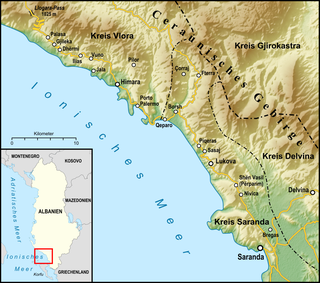
The Albanian Riviera, also popularly known as Bregu, is a coastline along the north-eastern Ionian Sea in the Mediterranean Sea, encompassing the districts of Sarandë and Vlorë in south-western Albania. It forms an important section of the Albanian Ionian Sea Coast, dotted with the villages of Palasë, Dhërmi, Vuno, Himara, Qeparo, Borsh, Piqeras, Lukovë, and the city of Sarandë.

Llogara National Park is a national park centered on the Ceraunian Mountains along the Albanian Riviera in southwestern Albania, spanning a surface area of 1,769 ha (17.69 km2). The park's terrain includes large alpine meadows, vertical rock faces, precipices and dense forests. Most area of the park is covered by forests and was established in 1966 to protect several ecosystems and biodiversity of national importance. The International Union for Conservation of Nature (IUCN) has listed the park as Category II. The region has been recognised as an important Bird and Plant Area, supporting significant number of species.
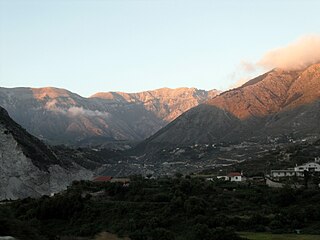
Dukat is a community in Vlorë County, southern Albania. With the 2015 local government reform, it became part of the municipality Vlorë. The Dukat Plain covers an area of around 1,000–1,500 ha delimited by the Ceraunian Mountains and opened in the north towards the Bay of Vlorë on the Adriatic. Dukat traditionally belongs to the Albanian ethnographic region of Labëria.
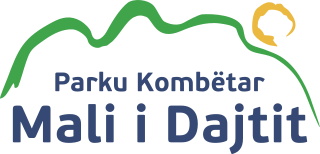
Dajti Mountain National Park is a national park established in 1966 in central Albania, spanning an area of 293.84 km2 (113.45 sq mi) since 2006. The park is 40 km (25 mi) east of the Adriatic Sea and 26 km (16 mi) east of Tirana. The area is under shared jurisdiction between Albanian Agency of Protected Areas (AKZM) and Tirana Municipality Parks and Recreation Agency (APR). It is adjacent to Shtamë Pass Nature Park to the northwest, Kraste-Verjon Protected Landscape to the west, and Mali me Gropa-Bizë-Martanesh Protected Landscape to the east. The park is marked by an extremely fragmented, rugged topography which creates favourable conditions for a great diversity of ecosystems and biodiversity.
Dhimitër Anagnosti is an Albanian film director and politician. He was a member of the Parliament of Albania in the 1990s and a Minister of Culture, Youth and Sports. For his contribution in film, he received the People's Artist of Albania medal. In 2011, former president Bamir Topi accredited him the "Honor of the Nation" order, Albanian: Urdhri "Nderi i Kombit".
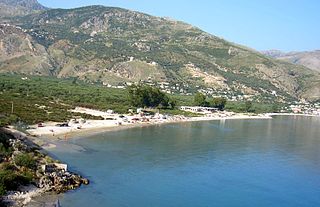
Qeparo is a seaside village in the municipality of Himara in Vlorë County, Albania. The village is part of the Albanian Riviera and is divided into two parts – Upper or Old Qeparo on higher ground, and Lower or New Qeparo on the coast. Qeparo is an Albanian-speaking village.

Vuno is a village in the municipality of Himarë, Vlorë County, Albania. It is located on the road that connects the centre of Himarë with the village of Dhërmi on the Albanian Riviera. The population of Vuno is exclusively Orthodox Albanian.
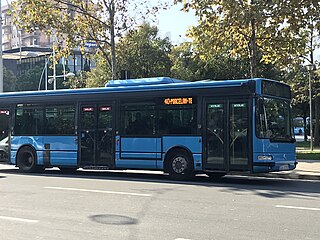
The Bus lines in Tirana refer to the bus lines operated by both private and public companies in Tirana, Albania. Despite the introduction of relatively new buses, passengers experience overcrowding and intermittent use of air conditioning on board.

The Karaburun tragedy of 2004, also known as the 9 January tragedy, was a marine incident that occurred during an attempted sea crossing from northern Albania to Italy by 36 people, including two dinghy operators and the smugglers' leader. They were trying to cross the Strait of Otranto, off the southern coast of Italy, in an inflatable boat, heading towards Brindisi, on the Adriatic coast of Apulia. Twenty-eight people died or were declared lost at sea, and there were only eight survivors. For Albanian emigrants, the tragedy had the second highest mortality rate for such events, after the Otranto tragedy of March 1997, when the Albanian ship Kateri i Radës, smuggling clandestine emigrants, was hit by the Italian warship Sibilla, resulting in the death of 84 people.
Leandro Zoto was an Albanian politician and mayor of Tirana from 1987 through 1988, precisely Chairman of the Executive Committee of the People's Council of Tirana. He has two sons, Edvin and Artur, with his wife Anastasia. He was born in Vuno.
Drago Siliqi was an Albanian poet, literary critic, and publisher. At the age of 14 he became a scout and then a partisan of the National Liberation Movement. He published his first collection of poetry, and then pursued university studies at the Maxim Gorky Literature Institute in Moscow.
The Qafa e Vishës bus accident occurred on 21 May 2012, at Qafa e Vishës near Himarë, Albania, when a bus plunged 80 metres (260 ft) off a cliff. Most of the victims were students of Aleksandër Xhuvani University of Elbasan. The driver is also believed to have been killed. The students were travelling from Elbasan to Sarandë.
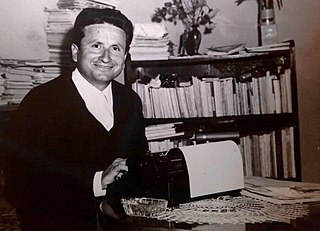
Odhise Kristo Grillo (1932–2003) was an Albanian writer of children's books.

The Highways in Albania are the central state and main transport network in Albania. The motorways and expressways are both part of the national road network. The motorways are primary roads with a speed limit of 110 kilometres per hour (68 mph). They have white on green road signs such as in Italy and other countries nearby. The expressways are the secondary roads, also dual carriageways, but without an emergency lane. They have a speed limit of 90 kilometres per hour (56 mph). They have white-on-blue road signs.
Sofokli Lazri (1923–2002) was an Albanian diplomat and publicist. In the 1980s he was the principal advisor of Albania's premier, Ramiz Alia, with regard to Albania's international relations. Lazri was the founder, in 1981, of the Institute of Studies of International Relations. He is also known as a publicist. His name has attracted controversy in Albania as some media have deemed him to be a secret agent of the Soviet Union's KGB.

The Thirrë-Kalimash Tunnel is a highway tunnel in Thirrë, Albania, part of the A1 Albania–Kosovo Highway. It is part of the South-East European Route 7. The tunnel is of great importance and, combined with the highway, has reduced the travel time between Tirana and the Kosovo border from 8 hours to 3 hours, with an estimated speed of 80–110 km/h. It has served to boost tourism Kosovan tourism in Albania and deepened cultural and economic ties between the two countries.

The Canyon of Gjipe is a bay and calcareous canyon located between Dhërmi and Vuno carved by the Ionian Sea in Vlorë County, Albania. The canyon occupies a length of 800 metres (2,600 ft) and a width that can varies between 10 metres (33 ft) and 20 metres (66 ft). It represents a narrow strait, created by the activity of the brook flowing through its narrow pass. There are numerous rock formations along the canyon, including a number of caves.













